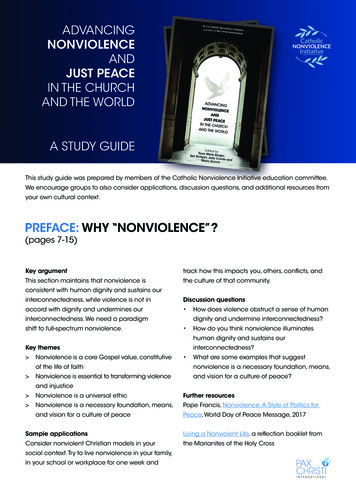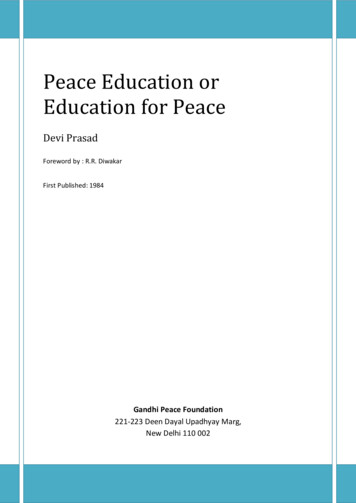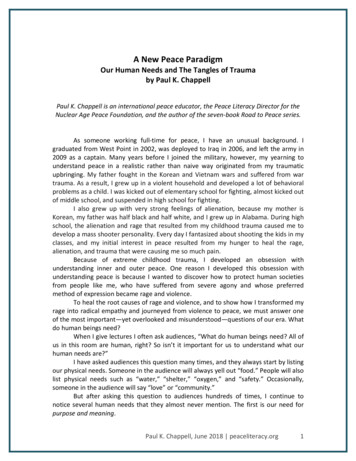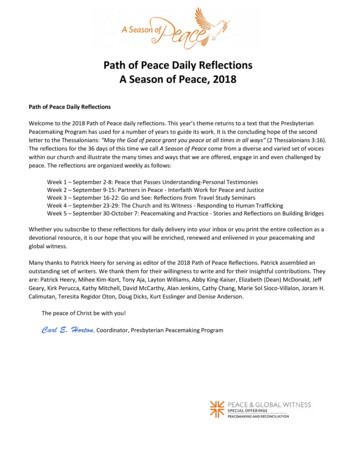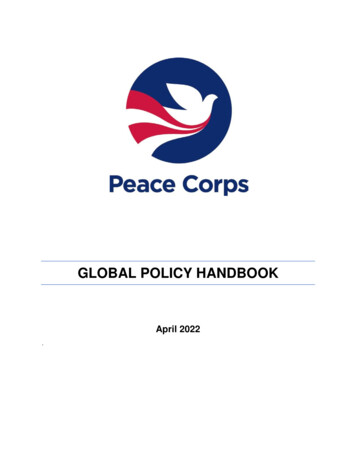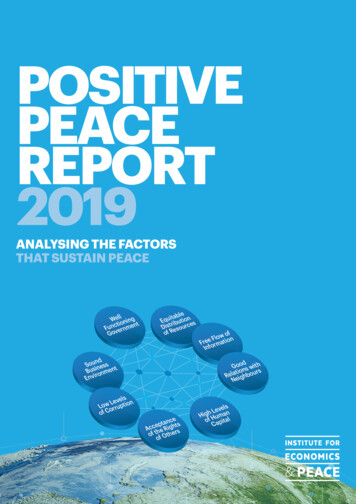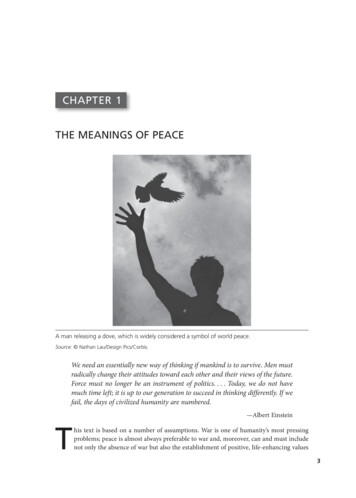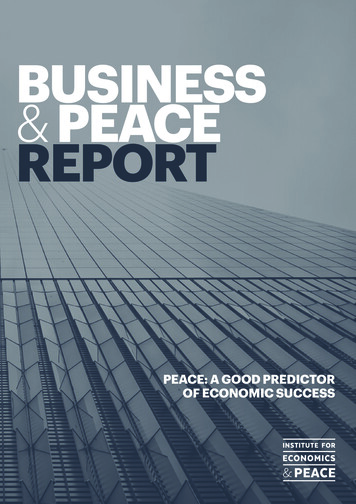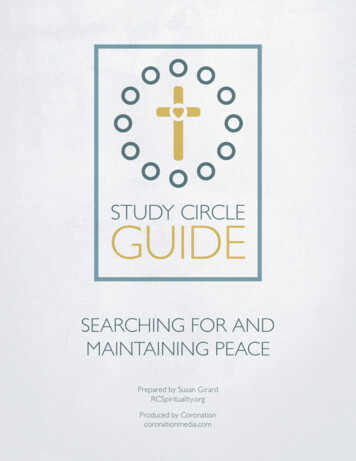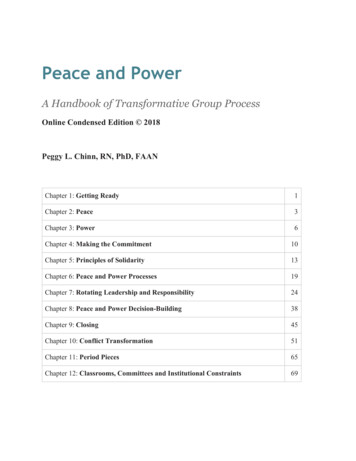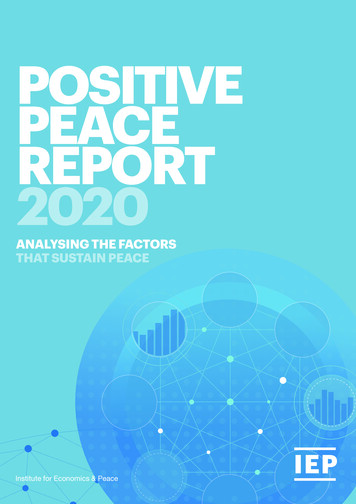
Transcription
POSITIVEPEACEREPORT2020ANALYSING THE FACTORSTHAT SUSTAIN PEACEInstitute for Economics & Peace
Quantifying Peace and its BenefitsThe Institute for Economics & Peace (IEP) is an independent, non-partisan, non-profit think tank dedicatedto shifting the world’s focus to peace as a positive, achievable, and tangible measure of human well-beingand progress.IEP achieves its goals by developing new conceptual frameworks to define peacefulness; providingmetrics for measuring peace; and uncovering the relationships between business, peace and prosperity aswell as promoting a better understanding of the cultural, economic and political factors that create peace.IEP is headquartered in Sydney, with offices in New York, The Hague, Mexico City, Brussels and Harare. Itworks with a wide range of partners internationally and collaborates with intergovernmental organisationson measuring and communicating the economic value of peace.For more information visit www.economicsandpeace.orgPlease cite this report as:Institute for Economics & Peace. Positive Peace Report 2020: analysing the factors that sustain peace,Sydney, December 2020. Available from: http://visionofhumanity.org/resources (accessed Date MonthYear).
ContentsWhy Positive Peace is TransformationalExecutive SummaryKey FindingsWhat is Positive Peace?12342468Section 1: Positive Peace Index, Results & Trends172020 Positive Peace Index RankingsGlobal Trends in Positive PeaceRisers and Fallers in Positive PeaceUS, China, EU and UK20222738Section 2: Positive Peace, Ethical Investment and Resilience43Positive Peace & Ethical InvestmentPositive Peace & Economic ResiliencePositive Peace & Social Resilience454852Section 3: Positive Peace & Changes in GPI Scores57Positive Peace Deficit as a Predictor of ViolenceRobustness of the Positive Peace Deficit ModelTipping Points in the Positive and Negative Peace Systems Dynamics Model586264Section 4: Implementing Positive PeaceCountry Case StudiesIEP’s Positive Peace ProgrammesAppendix A: Positive Peace Index MethodologyAppendix B: Positive Peace Index RankingsEndnotesPOSITIVE PEACE REPORT 2020 1686871767983
WHY POSITIVE PEACE ISTRANSFORMATIONALPositive Peace is a transformational concept. Empirically based, it shifts the focus away from the negative to the positiveaspects that create the conditions for a society to flourish. Due to its systemic nature, improvements in Positive Peace notonly strengthen peace, but are also associated with many other desirable outcomes for society, such as higher GDP growth,better measures of wellbeing and higher levels of resilience. Importantly, it provides a theory of social change, explaininghow societies transform and evolve.Humanity is nearing a tipping point and facing challenges unparalleled in its short history. Many of these problems areglobal in nature, such as climate change, ever decreasing biodiversity, depletion of the earth’s freshwater, andoverpopulation. Such global challenges call for global solutions and require cooperation on a scale unprecedented inhuman history. In a hyper-connected world, the sources of many of these challenges are multidimensional, increasinglycomplex and span national borders. For this reason, finding solutions requires fundamentally new ways of thinking.Peace is the prerequisite for the survival of humanity in the 21stcentury. Without peace, it will not be possible to achieve thelevels of trust, cooperation and inclusiveness necessary to solvethese challenges, let alone empower international institutionsand organisations necessary to address them. In the past, peacemay have been the domain of the altruistic but in the currentcentury it is clearly in everyone’s self-interest.Without an understanding of the factors that create and sustainpeaceful societies, it will not be possible to develop theprogrammes, create the policies or understand the resourcesrequired to build peaceful and resilient societies.Positive Peace provides a framework to understand and addressthe many complex challenges the world faces. Positive Peace istransformational in that it is a cross-cutting facilitator of progress,making it easier for businesses to sell, entrepreneurs andscientists to innovate, individuals to produce and governmentsto effectively regulate.In addition to the absence of violence, Positive Peace is alsoassociated with many other social characteristics that areconsidered desirable, including stronger economic outcomes,higher resilience, better measures of wellbeing, higher levels ofinclusiveness and more sustainable environmental performance.Therefore, Positive Peace can be seen as creating an optimalenvironment in which human potential can flourish.Understanding what creates sustainable peace cannot be foundin the study of violence alone.A parallel can be drawn with medical science. The study ofpathology has led to numerous breakthroughs in ourunderstanding of how to treat and cure disease. However, it wasonly when medical science turned its focus to the study ofhealthy human beings that we understood what we needed to doto stay healthy: physical exercise, a good mental disposition, asense of purpose and a balanced diet are some examples. Thiscould only be learned by studying what was working. In the sameway, the study of conflict is different from the study of peace,producing very different insights.Positive Peace is systemic and requires new thinking to beproperly understood. Systems thinking originated in the study oforganisms and has been extended into sociology. It can alsoassist in understanding the way countries and nations functionand evolve. When combined with Positive Peace, systemsthinking provides new ways of conceptualising and explainingsocietal change. As one example — a system is more than thesum of its parts, and cannot be understood merely by breaking itdown and analysing its constituent parts. Positive Peace consistsof eight Pillars, but each of these Pillars does not correlate withpeace as strongly as the sum of all components, highlighting thatthe whole is more than the simple sum of its components.This distinctly contrasts with the notion of linear causality, whichdominates decision making today: identify a problem, decideupon its cause and tackle the root. Without a fullerunderstanding of underlying system dynamics, the linearapproach creates unintended consequences. The failure to solvesome of society’s fundamental challenges is a testimony to this.Systems thinking opens new ways of understanding nations andhow they evolve. In systems, relationships and flows are moreimportant than events. Events or problems represent theoutcomes of the relationships and flows. This is why it isimportant to look at the multidimensional concept of PositivePeace as a holistic, systemic framework.Positive Peace defines the goals that a system needs to evolvetoo. Interventions should nudge the system towards ever higherlevels of Positive Peace, rather than creating radical change,which runs the risk of disrupting the fabric of society.Importantly, viewing nations as systems provides a framework forunderstanding the relationships between humanity and thebroader systems, such as the atmosphere and biosphere, whichwe intersect and depend upon. Systems are self-regulating andself-modifying and operate on two levels; first as a collection ofinterconnected subsystems and second as part of the largersystems surrounding it. Understanding these interdependenciesis essential to meeting the global challenges of our age.Different countries have different aims, or intent. Societies alsohave both formal and informal rules, referred to as encodednorms, which govern social behaviour and aim to maintain thesystem in a stable state. They regulate inputs, creating mutualfeedback loops. This can be observed in many societalprocesses, such as when a government stimulates the economyin response to a drop in GDP or deploys more policing resourceswhen there is a rise in crime. Each country’s system will bePOSITIVE PEACE REPORT 2020 2
unique with different social norms and governance, althoughfollowing the same general principles.With differences in intent and encoded norms, any two nationsmay react differently to the same stimulus. Tipping points alsooccur within systems due to lagged and non-linear relationships.IEP’s research uncovers evidence of tipping points in relation topeace and corruption, peace and per capita income, to namesome examples. In the past, societies have been investigatedthrough the lens of causality; in the future, embracing theseholistic, systemic approaches will forge our ability to navigate anage of unprecedented challenges.Seen in this light, Positive Peace and systems thinking comprisean overarching framework for understanding and achievingprogress not only in the level of global peacefulness, but in manyother interrelated areas, including better economic progress andsocial advancement.Positive Peace provides the optimal environment for humanpotential to ironmentLow Levels ofCorruptionAcceptanceof the Rightsof OthersEquitableDistributionof ResourcesPEACEHigh Levelsof HumanCapitalFree Flow ofInformationGoodRelations withNeighboursPOSITIVE PEACE REPORT 2020 3
Executive SummaryThis report details the latest findings from IEP’s research into Positive Peace, including country rankings and their changesover time. The report also analyses the relationship between development and Positive Peace, finding that Positive Peaceacts as a catalyst for better development outcomes.Positive Peace is defined as the attitudes, institutions andstructures that create and sustain peaceful societies. The samefactors that create lasting peace also lead to many otherpositive outcomes that societies aspire to, including: thriving economiesbetter performance on ecological measureshigh levels of resilience and adaptability to change.Other factors that improve with Positive Peace are measures ofinclusiveness, wellbeing and happiness. Therefore, PositivePeace can be described as creating an optimal environment forhuman potential to flourish.Positive Peace is conceptually and empirically linked tosocio-economic resilience. Countries with high Positive Peaceare more likely to maintain their stability and recover moreeasily from internal and external shocks. Through the modellingof the relationship between Positive Peace and the actualpeace of a country, as measured through the Global PeaceIndex (GPI), it is possible to predict large falls in peace. A modelbased on Positive Peace deficits was able to predict 90 percent of the countries that would deteriorate in peace over thepast decade. Additionally, seven of the ten largest falls on theGPI were also predicted by this model.The data used in this report covers the period from 2009 to2019. As such, it does not include the impact of the COVID-19pandemic, lockdowns and the global recession that ensued. Itwill be included in forthcoming editions of the Positive PeaceIndex (PPI), as well as other upcoming IEP publications such asthe GPI and the Business and Peace report.Analysis finds that Positive Peace is strongly correlated withbetter economic outcomes. Countries that develop high levelsof Positive Peace display greater degrees of economic strengthand resilience. Countries that improved in Positive Peacebetween 2009 and 2019 had annual per capita GDP growthalmost three percentage points higher than countries thatdeteriorated in Positive Peace. As such, Positive Peace can beused in financial markets helping investors identify reliable andsustainable growth opportunities. In addition to improvementsin GDP, Positive Peace is statistically associated with betterperformance in a range of other macro-economic indicators,including stronger flows of foreign direct investment,appreciating currencies and lower and more stable interest andinflation rates.Trends in Positive Peace can be used to forecast futureeconomic outperformance in countries. This is an invaluabletool for financial analysts seeking to complement theirtraditional macroeconomic forecasting models. This analysis isdiscussed in this report and will be further developed in theupcoming Business and Peace publication.Positive Peace is also conceptually and empirically linked withthe notion of ethical investing, or as it is often described,environmental, social and governance (ESG) investing. PositivePeace is statistically linked to improvements in ESG measuresand as such can be seen as creating the backgroundenvironments where countries will perform well in suchmeasures. Positive Peace can be used as a predictor of superiorESG performance and can be applied in the design of impacttype investment strategies or as a risk assessment andmanagement tool.Global levels of Positive Peace have improved since at least2009, with 134 of the 163 countries, or 82 per cent, improving inthe PPI over this period. Positive Peace improves slowly,therefore planning needs to be longitudinal. Much of theprogress since 2009 is due to improvements within theStructures domain of Positive Peace, which includes measuresrelated to economic, technological and scientific development.They tend to grow almost uninterruptedly, reflecting thecontinuous increase in national incomes, the constantdevelopment of new technologies and the permanent stream ofnew discoveries in science and health.In contrast, factors relating to social behaviour and socialrelations, as measured by the Attitudes domain, havedeteriorated considerably over the past decade. These factorsmeasure social views, tensions and perceptions and have beennegatively affected by a rise in corruption, greater polarisationof political views, the intensification of tensions between socialgroups and the dissemination of false information. Somecountries have experienced steep declines in this domain,including developed countries, such as Denmark, theNetherlands, Austria, the US and the UK.Six of the eight Pillars of Positive Peace have improved over thelast decade. The Pillars with the greatest improvements wereFree Flow of Information and Sound Business Environment.These developments mostly reflect the dissemination ofinformation technologies and the growth in goods and servicesconsumption and trade. High Levels of Human Capital alsoimproved markedly, on the back of greater access to educationand professional training. It was also influenced by increasedtechnical and scientific research output.However, the Pillars Low Levels of Corruption and WellFunctioning Government, deteriorated globally. Eithercorruption itself has become more prevalent over the lastPOSITIVE PEACE REPORT 2020 4
decade or perceptions of it have deteriorated. Overall, LowLevels of Corruption deteriorated in 103 of the 163 countriesassessed by the PPI. In line with these developments,governments have also become less effective and reliable, withthe Well-Functioning Government Pillar deteriorating in 98countries since 2009. These are serious concerns. Simply addressing the factors that led to violence in thepast will not be enough to sustain peace in the future.Different aspects of the social system push societiestowards or away from peace, which means thatimprovements in peace require broader and more systemicstrategies than once thought.The research also incorporates systems thinking, whichprovides a more accurate understanding of how nationsoperate and societies develop over time, rather than thetraditional approach of cause-and-effect linear thinking. Theintroductory section of the report describes the fundamentalconcepts associated with systems thinking. Adopting thisapproach, IEP develops a new interdependent framework andholistic methodology to the study of peace and societaldevelopment. Prevention should be the priority. Recovery after violencehas already occurred is difficult, expensive, and requireswidespread effort to rebuild Positive Peace. Throughfocusing on the factors that are most critical, it is possibleto build resilience in cost-effective ways. Stopping or averting conflict is not an end in itself. AsPositive Peace progresses, it enables an environment wherehuman potential may more easily flourish.When combined with systems thinking, the analysis of PositivePeace produces a new theory of social change. Developmentsin Positive Peace precede societal changes in peacefulness,either for better or worse. Stimuli and shocks have cascadingeffects, due to the feedback loops contained within nationalsystems, pushing societies into virtuous or vicious cycles.However, these cycles can be understood, planned andmoulded to produce the best social outcomes. Positive Peaceprovides a roadmap of the things societies need to change, toeither consolidate virtuous cycles or break vicious ones.Each Pillar of Positive Peace represents a complex set of socialdynamics. Research finds that different Pillars become moreimportant at distinct stages of development. In low-peacecountries — those struggling with external wars, civil wars orinternal insurgencies — improvements in the Pillars Low Levelsof Corruption, Acceptance of the Rights of Others, GoodRelations with Neighbours, Sound Business Environment andWell-Functioning Government are critical for the reduction ofviolence. As countries progress toward higher levels ofpeacefulness, further reductions in violence requireimprovements in Free Flow of Information, Equitable Distributionof Resources and High Levels of Human Capital. The eight Pillarsbuild on one another to consolidate previously acquiredsuccesses.Additionally, improvements in a single Pillar, withoutimprovements in other supporting Pillars can lead to a higherlikelihood of deteriorations in peace. Focusing exclusively onbuilding stronger business environments or higher levels ofeducation, for example, may prove to be problematic.Countries, like systems, evolve and therefore the unique factorswhich constitute the make-up of a country need to beunderstood for interventions to be successful. Radical changealso creates instability and risk. The best approach is manysmall, progressive nudges towards virtuous cycles of greaterPositive Peace. Once a cycle is underway, it tends to beself-reinforcing. This is the nature of systems.Taken together, the findings in this report have importantimplications for building and sustaining peace: There are no quick and easy solutions. Building andsustaining peace requires a large number of society-wideimprovements progressing in concert with one another overlong periods of time.Positive Peace can also be applied practically throughworkshops and development projects on a national, state orcommunity level. IEP has implemented workshops in all majorregions of the world. Included in this report are examples of IEPprogrammes conducted in the Philippines, Ethiopia, Mexico,Uganda and Japan, all aimed at building Positive Peace in thesecountries and communities.Without a better understanding of how societies operate, it willnot be possible to solve humanity’s major global challenges.Positive Peace provides a unique framework from which tomanage human affairs and relate to the broader ecosystemsupon which we depend. Positive Peace in many ways is afacilitator, making it easier for workers to produce, businessesto sell, entrepreneurs and scientists to innovate andgovernments to serve the interests of the people.Positive Peace provides aroadmap of what societiesneed to change to eitherconsolidate virtuous cyclesor break vicious ones.POSITIVE PEACE REPORT 2020 5
KeyFindingsPositive Peace Fundamentals Positive Peace is defined as the attitudes,institutions and structures that create and sustainpeaceful societies. These same factors also lead to many otherpositive outcomes that society feels areimportant, such as economic strength, socialresilience and wellbeing. Therefore, Positive Peace creates the optimalenvironment for human potential to flourish. The most peaceful countries in the world performstrongly on all eight Pillars of Positive Peace. High Positive Peace countries are more likely tomaintain stability, adapt and recover from shocks. Countries that perform well in Positive Peace aremore likely to achieve and sustain high levels ofpeace.Global and Regional Trends More countries improved in Positive Peace — 134in total — than deteriorated — 29 countries —from 2009 to 2019. These improvements were mainly driven bythe Sound Business Environment, Free-Flow ofInformation, Equitable Distribution of Resourcesand High Levels of Human Capital Pillars. Positive Peace improved 3.3 per cent globally inthe past decade. This is driven by improvementsin six of the eight Pillars of Positive Peace since2009. Eight out of the nine world regions improved inPositive Peace since 2009, with North Americabeing the only exception. Russia and Eurasia, Asia Pacific, South Asia andEurope had the largest regional improvements.All countries in Russia and Eurasia recordedimprovements in the PPI. Higher levels of Positive Peace are mainly due toimprovements in the Structures domain of thePPI, while the Institutions domain was broadlysteady and the Attitudes domain deterioratedmarkedly. This means the world has become richer andmore apt at technology, but the ways in which wetreat one another have become measurably moreintolerant.Positive Peace, EthicalInvestment and Resilience Positive Peace has a high correlation withindicators of environmental, social andgovernance (ESG) investment. Designers offinancial products and benchmarks can use thiswhen catering for the growing demand for ethicalinvestment. Positive Peace is a reliable gauge of economicresilience. As such, it can be used to selectportfolios of countries that consistentlyoutperform global GDP growth. The combinedGDP of PPI improvers outgrew global averagesby almost one percentage point per year since2009. This outperformance is also verified for otherindicators of macroeconomic activity andnational governance. The PPI can also be used as a tool to helpforecast future economic outperformance insovereign markets. Inflation rates in countries where Positive Peacedeteriorated were four times more volatile whencompared to countries where Positive Peaceimproved. Domestic currency in countries where PositivePeace improved appreciated by over onepercentage point per year more than countrieswhere the PPI deteriorated. Countries that improved in Positive Peace alsohave a more positive outlook on credit ratingas assessed by Standard & Poor’s, Moody’s andFitch. Among countries where Positive Peace improved,household consumption rose in the past decadeat a rate almost twice as high as for countrieswhere the PPI deteriorated.POSITIVE PEACE REPORT 2020 6
Positive Peace & Changesin the Global Peace Index Countries that have a higher rank in negativepeace than in Positive Peace are said to have aPositive Peace deficit. This is where a countryrecords a level of peacefulness higher than canbe sustained by its internal socio-economicdevelopment. Most countries found to be indeficit subsequently record increasing levels ofviolence. Low Levels of Corruption, Acceptance of theRights of Others, Sound Business Environment,Well-Functioning Government and GoodRelations with Neighbours are the most importantPillars requiring improvement in countriessuffering from high levels of violence. Free Flow of Information, Equitable Distributionof Resources and High Levels of Human Capitalbecome more important as countries move awayfrom very low levels of peace. Sixty-nine per cent of countries with a PositivePeace deficit of 20 places or more in 2009 hadsubstantial deteriorations in the Global PeaceIndex (GPI) from 2009 to 2019. Low Levels of Corruption is the only Pillar that isstrongly correlated with the GPI across all levelsof peacefulness. Improvements in this Pillar areassociated with reductions in violence in lowpeace, medium-peace and high-peace countries. When the threshold is raised to 50 places, theproportion of deficit countries experiencingsubsequent increases in violence rises to 90 percent. Uneven improvements in the Pillars of Peacecan lead to increased violence, highlighting theimportance of a holistic approach to buildingPositive Peace. The ten largest deteriorations in the GPI rankingfrom 2009 to 2019 were recorded by Libya,Nicaragua, Burkina Faso, Egypt, Syria, Bahrain,Mozambique, Cameroon, Tunisia and Ukraine.Of these ten countries, seven had large PositivePeace deficits in 2009. This underscores thepredictive power of the Positive Peace deficitmodel. On average, deficit countries that recordedincreases in violence saw their GPI InternalPeace score deteriorate by 17.8 per cent from2009 to 2019. This compares to a 0.3 per centdeterioration over the period for the mediancountry in the GPI. Looking forward, 30 countries recordedsubstantial Positive Peace deficits in 2019, andmay deteriorate further into violence in thecoming years. Of particular concern, Eritreaand the Equatorial Guinea combine largePositive Peace deficits with a long trend of PPIdeteriorations over the past decade. Other nations in deficit in 2019 — such asLiberia, Zambia, Guinea-Bissau, Bangladesh,Qatar, Rwanda and Zimbabwe — have alreadyrecorded PPI deteriorations in more recentyears.POSITIVE PEACE REPORT 2020 7
WHAT ISPOSITIVE PEACE?FIGURE A.1NEGATIVEPEACE. is the absence ofviolence or fear ofviolence. Positive Peace is defined as the attitudes,institutions and structures that create andsustain peaceful societies. These same factorsalso lead to many other positive outcomesthat society feels are important. Higher levelsof Positive Peace are statistically linked tohigher GDP growth, better environmentaloutcomes, higher measures of wellbeing,better developmental outcomes and strongerresilience. Positive Peace has been empirically derived byIEP through the analysis of thousands of crosscountry measures of economic and socialprogress to determine which have statisticallysignificant relationships with actual peace asmeasured by the Global Peace Index (GPI).POSITIVEPEACE. is the attitudes,institutions & structuresthat create and sustainpeaceful societies. Positive Peace is measured by the PositivePeace Index (PPI), which consists of eightPillars, each containing three indicators.This provides a baseline measure of theeffectiveness of a country’s capabilities tobuild and maintain peace. It also provides ameasure for policymakers, researchers andcorporations to use for effective interventiondesign, monitoring and evaluation. Positive Peace can be used as the basis forempirically measuring a country’s resilience— its ability to absorb, adapt and recover fromshocks, such as climate change or economictransformation. It can also be used to measurefragility and help predict the likelihood ofconflict, violence and instability.FIGURE A.2The Pillars of Positive PeaceA visual representation of the factors comprisingPositive Peace. All eight factors are highlyinterconnected and interact in varied and EnvironmentLow Levels ofCorruptionAcceptanceof the Rightsof OthersPOSITIVE PEACE REPORT 2020 8EquitableDistributionof ResourcesPEACEHigh Levelsof HumanCapitalFree Flow ofInformationGoodRelations withNeighbours
POSITIVE PEACE &SYSTEMS THINKINGThis section describes how Positive Peace can reinforce and build the attitudes, institutions and structures that allowsocieties to flourish. These same factors create resilient and adaptive societies that pre-empt conflict and help societieschannel disagreements productively.Positive Peace as a term was first introduced in the 1960s andhas historically been understood qualitatively, based on idealisticor moral concepts of a peaceful society. The distinguishingfeature of IEP’s work on Positive Peace is that it is empiricallyderived. Statistical analysis was used to identify the commoncharacteristics of the world’s most peaceful countries. Ittherefore forms an important evidence base to understandPositive Peace and avoids subjective value judgements.To construct the Positive Peace Index, nearly 25,000 nationaldata series, indexes and attitudinal surveys were statisticallycompared to the internal measures of the GPI to determinewhich factors had the highest statistical correlations. Indicatorswere then qualitatively assessed and where multiple variablesmeasured similar phenomena, the least significant weredropped. The remaining factors were clustered using statisticaltechniques into the eight Pillars of Positive Peace. Threeindicators were selected for each Pillar that represent distinctbut complementary conceptual aspects. The index wasconstructed with the weights for the indicators being assignedaccording to the strength of the correlation coefficient to the GPIInternal Peace score. This empirical approach to theconstruction of the index means it is free from pre-establishedbiases or value judgements.BOX A.1Measuring peace: the Positive PeaceIndex and the Global Peace IndexThe Global Peace Index (GPI) is produced annually byIEP, and ranks 163 independent states and territoriesaccording to their level of peacefulness. It stands asthe world’s leading measure of global peacefulness.The GPI is composed of 23 qualitative andquantitative indicators from highly respectedsources, covering 99.7 per cent of the world’spopulation. The index measures global peace usingthree broad themes: the level of safety and securityin society; the extent of domestic or internationalconflict; and the degree of militarisation. For the full2020 report or to explore the interactive map ofglobal peace, visit www.visionofhumanity.org.The Positive Peace Index (PPI) measures the level ofPositive Peace in 163 countries. The PPI is composedof 24 indicators that capture the eight Pillars ofPositive Peace. Each indicator was selected based onthe strength of its statistically significant relationshipwith the GPI.
Peace can be described as creating an optimal environment for human potential to flourish. Positive Peace is conceptually and empirically linked to socio-economic resilience. Countries with high Positive Peace are more likely to maintain their stability and recover more easily from internal and external shocks. Through the modelling
